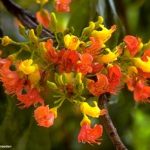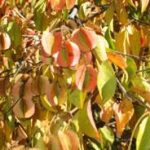TREE LIFE
May 2016
ANNUAL SUBS ARE DUE – if you would like to be able to vote at the AGM in May, please pay your $10 now (see payment details at the end).
MASHONALAND CALENDAR
Saturday 7th May: Botanic Garden Walk. Meet at the car park at 0845 hours for 0900 hours. Come and enjoy the treasures – new every month – that the Garden has to offer.
Sunday 15th May: Tree Society AGM 9.30am Mukuvisi Woodlands (see following notice). Please bring a plate of eats to share.
Saturday 28th May : Visit to CABS Headquarters gardens. We will explore the gardens at CABS headquarters (where we usually leave our cars for shared lifts on Sunday outings). These grounds have an exciting range of both indigenous and exotic trees that have been well laid out in a beautiful garden. Meet at 1430 hours
REMINDER: Notice of the Annual General Meeting of the Tree Society
Notice is hereby given that the 66th Annual General Meeting of the Tree Society of Zimbabwe will be held at the Education Centre, Mukuvisi Woodlands on Sunday 15th May 2016 at 9.30 am.
Any proposals/resolutions and nominations for office bearers (and any volunteers to be on the Committee) should be forwarded to the Secretary Teig Howson at teig.howson@gmail.com by Sunday 1st May if possible, although proposals and nominations will be accepted from the floor.
AGENDA
- Notice convening the meeting.
- Apologies.
- Minutes of the 65th A.G.M.
- Matters Arising.
- Chairman’s Report.
- Treasurer’s Report.
- Election of Committee Members.
- Any Other Business.
Tree Society Web site
The committee has decided that the Tree Society web site needs to be modernised to give it a new look and make it more attractive. However the committee knows little about websites and so we are appealing to you, the members, for help. Have a look at the web site as it is now :
https://www.lind.org.zw/treesociety/index.htm
and make your suggestions to any Tree Society committee member.
What we would like to know: How should it look? What should be included on it? How should it work? Should there be links to any other website? Etc.
– Tony Alegria
AUTUMN GOLD
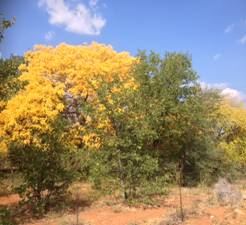
Kirkia acuminata, White Syringa ablaze in deep yellows and gold. A spectacular sight worthy of foliage tourism status indeed
The foliage of trees can equal the marvel of flowers. Now put pure stands of these trees together and one creates something so attractive that an industry based on foliage tourism develops. I am thinking of the Msasa trees in new leaf in August in Nyanga and the Aspen and Maple leaves in north-eastern USA and Canada .
Individual trees like Hymenodictyon floribundum, aptly called the Firebush, are displaying their splendour at present in Domboshawa. Ficus ingens in its spring foliage, Pseudolacnostylus maprouneifolia (Kudu-berry) and Bridelia micrantha (Mitzeerie) in autumn leaf are only a few examples of trees growing in semi-isolation that put on a good show at certain times of the year. Pretty to behold but they are somewhat insular, “one man” shows.
On a recent trip back from South Africa (mid April) I decided to try a border post other than Beitbridge to return home. Platjan was decided on. There are at least 5 border posts along the Limpopo River but Pont Drift and Platjan take one into the Tuli Block. The former has no bridge so is rainfall dependent and may need a 4 X 4 whereas all the others have low drifts or bridges crossing the Limpopo. Before reaching the border post we drove along the northern flanks of the Soutpansberg and bands of Commiphora glandulosa (Tall Common Corkwood) were turning into remarkable autumn dress but in a subdued sort of way. Almost like they just quietly resigned themselves to the coming of winter. The far western end of the range has the salt pans that give this botanical hotspot its name.
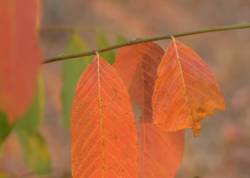
Hymenodictyon floribundum, leaves, aptly called the Firebush
On crossing into Botswana I was amazed at the rich evidence of recent elephant activity that I encountered. Tracks, dung, diggings and broken branches were everywhere to be seen. What a welcoming sign of the well managed wilderness area of Botswana. I had just done a three day mountain bike ride in the Zambezi Valley upriver of Chirundu Hunting Area, which should be famous as a Loxidontal location, to see fresh evidence of only two elephants over three days on the river and inland roads!
Once one leaves (pun intended) the riverine road on the Limpopo with its huge weeping Boer-bean trees, Scotia brachypetala, and sweet-scented, seed-bearing Acacia nilotica-lined rivulets and heads inland to Selebi Phikwe, the terrain changes to Kalahari sands in gentle undulations of drainage lines and low dune crests. It was here on the higher-lying stretches of Kalahari sand that the marvel of Kirkia acuminate (White Syringa) expressed itself. These trees grew in perfusion and were ablaze in deep yellows and gold. A spectacular sight worthy of foliage tourism status indeed. There was a roar of gleaming, bright colour coming off these trees. The trees grew in broad bands of shades of golden yellow that meandered along the old dune lines, interspersed with green, almost like a Springbok rugby jersey only that yellow far outweighed the greens.
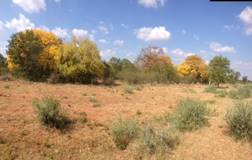
Autumn Gold – The foliage of trees can equal the marvel of flowers
To see this from a low-flying helicopter must be as spectacular a view to angels and man alike as the more well-known natural wonder of the world, the Victoria Falls. Compared to the subdued Commiphoras in the Soutspansberg, these trees seem to be laughing into the face of oncoming winter.
They were embracing the coming of winter, challenging the seasonal dry months, keeping their best act for last.
Air travel may be fast and convenient and soon forgotten, but a trip by car not involving Beitbridge is a marvel that is remembered in detail and for the rest of one’s life.
– Karl Van Laeren
Footnote: Another area even richer in Kirkia acuminata trees is on the Botswanan road from the Maitengwe border-post (north of Plumtree) towards the Nata road via Tutume and Mosetse.
Second footnote: Note that the Journal of the Government Herbarium in Salisbury (now Harare) originally chose KIRKIA as the title of their botanical journal, covering issues from Zambia and Zimbabwe.
Botanic Garden Walk – 2nd APRIL 2016
There were only five of us to enjoy this beautiful April morning – Mary, Peter and Frances, Dave and Ann. We set off towards the Lowveld section as Dave had noted that the Baikiaea plurijuga , Rhodesian Teak, was in flower. Most of the trees we looked at grow in Kalahari sand in the Lowveld.
Stepping up from the car park we noted that the Bauhinia petersiana with it’s curling twigs had fresh green pods, as did the Xeroderris stuhlmannii. This is a very good specimen, the flowers are greenish white and only come out at night, so are usually only visible in the early morning. The flat pods were newly formed and a fresh green at this stage.
The Kirkia acuminata leaves are turning yellow to gold, these are a spectacular site when you see a rocky hillside covered with these trees, as Karl van Laeren also commented in the previous article. The late rains have been so good for the trees which are looking lush and healthy.
The Marula, Sclerocarya birrea is looking good and the Baobab, Adansonia digitata now a sizable tree. Ziziphus mucronata, the Buffalo thorn, is in full leaf and fruit as well as new flowers while the Baikiaea plurijuga that we had been looking for had a spray of pink flowers near the top of the tree.
Grewia flavescens has square stems as its identifying feature and it was in fruit, though still green. The Peltophorum africanum we saw was a very old-looking tree with lichen covering the branches, but it must have flowered profusely this year, judging from the number of young pods on the tree.
Three Acacia erioloba, the Camel Pod Acacia, are small and old. With more access to water they become sizable trees in their natural habitat in the West of Zimbabwe, Victoria Falls and Hwange, where they are the major species in the dry areas. The pods are a very good fodder for stock, though at certain times of the year they can be poisonous.
Combretum imberbe the Leadwood, has a very distinctive bark, smoothish to start with and then cracked into rectangular flakes, dark grey to almost black in colour. Logs are burnt by the local people who mix the ash with water and paint their houses white. Logs make the best camp fires because they burn slowly all night.
Next was Diospyros senensis, the Spiny jackal berry. This is a large multi-stemmed specimen with the fruit just forming that resembles an acorn, while Combretum zeyheri has the largest fruit of the Combretum family. Combretum hereroense, the Mouse-eared Combretum is a small tree or a scrambler. The leaves are soft to touch and are shaped like a mouse’s ear. The fruit is very distinct: four winged, a rich chestnut brown that is darker towards the centre.
The Manketti tree, Schinziophyton rautanenii a member of the Euphorbiaceae, is a good medium-sized tree. The fruits are ovoid in shape, covered in velvety hairs, and nearly ripe. It is edible and contains a single seed which is hard and when cracked open contains an edible kernel that provides an edible oil.
A small tree next to this is Baphia massaiensis: leaves obovate, flowers white in short sprays, jasmine scented, fruit a long narrow woody pod with a pointed tip.
Plumbago zeylanica, with white flowers and a point at the tip of the petals, was growing at the base of a tree, more a creeper than a shrub. Nearby a dainty blue flower, Commelina livingstonia which protrudes from a folded spathe, is a much-branched herb with simple leaves, broadly ovate. The blue flower has two large petals and one very small one. Linnaeus named this flower after three Commelin brothers. Two were strong and healthy but the third small and sickly. Johan Commelin was a Dutch botanist (1629-1692).
Other trees that we came across were:
Ficus burkei with small fruit a pale green at this stage; Lannea discolor, the Live long tree, is called the old lady tree because of it’s wrinkly skin; Acacia ataxacantha a shraggy shrub; Acacia eriocarpa the woolly pod Acacia, with white flowers in spikes and scattered hooked thorns; Acacia gerrardii pods are sickle shaped, flowers white balls the thorns can be 5 to 6 cm straight and very stout; Terminalia prunioides with striking purple or plum red fruit in the autumn and winter; Triplochiton zambesiacus grows into a large spreading tree, the Zambezi oak with five to nine lobed, simple leaves. The fruit has five carpels with a stiff membranous wing, straw-coloured and usually furry like a moth’s wing; The Torch Tree, Balanites maughamii (pronounced as Meg says like Somerset Maugham – ee – i) has Y-shaped thorns; Erythroxylum zambesiacum the Zambezi coca-tree, distinguished by rather small obovate leaves and the bright red ellipsoid fruit small and only up to 8mm long.
The last tree we discussed was Antidesma venosum the Tassleberry, an impressive specimen. The fruit hangs in pendulous spikes, fleshy when young and turning bright red and finally purple-black. This is an attractive garden tree though you need both a male and female tree to produce fruit.
Thank you everyone who came on this walk to make it a very interesting morning. Thank you also to Chris who was able to join us for half an hour.
– Ann Sinclair
OUTING TO MAZOWE SPRINGS 23rd APRIL 2016
Seventeen of us took advantage of a most beautiful April afternoon to meet at Barbara Kockott’s lovely home at Mazowe Springs. We were very happy to welcome Fungisai and Corrie who joined the group for the first time – we really hope you enjoyed it and will come again.
Barbara did us proud and organised with Taffy – Taffy is the owner or the piece of land on which the Mazowe Spring is located – that we could walk down to the Spring and explore the area botanically and revel in the beauty of the place, cool and calm and peaceful. (For me personally it brought back memories of wonderful days of working dogs and it was good to see how well maintained the area is). Not only did Barbara organise that we could walk in this area, but she also organised that a path be trimmed for ease of access.
At the Spring we split into two groups each taking a different side of the stream, crossing the little dam wall and then coming back on the other side of the stream. A lovely walk. We then wandered back to the main complex and discussed and named the indigenous trees which have been planted in the complex over the years. I hope Barbara was pleased with this result as this had been her primary objective when inviting the Tree Society out.
There was not a very serious record taken of all the tree seen in the Spring area, but these are some of the species that were recorded: Acacia sieberiana, Celtis africana, Cussonia arborea, Diospyros lycioides, Erythrina abyssinica, Ficus sur, Gymnosporia (ex Maytenus) senegalensis, Pavetta gardeniifolia, Rhamnus prinoides, Rhoicissus revoilii, Syzygium cordatum, Vernonia myriantha, Ziziphus mucronata, with Syzygium cordatum being the dominant species. There had been leopard trees planted within the area and several people asked the about the scientific name, Caesalpinia ferrea, and where they came from when they heard these are not indigenous. They are native to eastern Brazil.
The planted trees within the Mazowe Springs complex were a good mix of indigenous species with a few exotics thrown in. Barbara recorded them as she plans to label them. They are:
Croton megalobotrys – large fever berry; Bridelia micrantha – Mitzeeri; Pittosporum viridiflorum – Cheese wood; Erythrina lysistemon – Common coral tree; Rauvolfia caffra – Quinine tree; Apodytes dimidiata – White pear; Searsia lancea – spear shaped leaves?; Trichilia dregeana – Forest mahogany; Adansonia digitata – Baobab; Sterculia africana – African star-chestnut; Piliostigma thonningii – Camel’s foot; Cussonia arborea – Octopus cabbage tree; Terminalia sericea – Silver cluster-leaf; Ziziphus mucronata – Buffalo thorn (blinkblaar wag-‘n-bietjie); Combretum molle – Velvet bushwillow; Kigelia africana – Sausage tree; Trema orientalis – Pigeon wood; Dombeya burgessiae – Pink wild pear; Schefflera umbellifera – False cabbage tree; Peltophorum africanum – Weeping wattle; Ficus thonningii (burkei) –Common wild fig; Senna petersiana – Monkey pod, flowers in summer and autumn; Senna singueana – flowers in winter-spring growing in my garden; Ficus ingens – Red-leafed fig; Dovyalis caffra – Kei-apple; Schotia brachypetala – Weeping boer-bean; Koelreuteria paniculata – Chinese rain tree; Koelreuteria henryi – Taiwanese rain tree; Caesalpinia ferrea – Leopard tree; Norfolk Island Palm; Australian Acacia.
To crown a really special afternoon Barbara then served us with a fabulous tea, cakes, sandwiches, biscuits, the whole toot, all so very graciously served. A very special afternoon indeed and thank you Barbara for making it so.
– Mary Lovemore
TONY ALEGRIA


